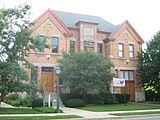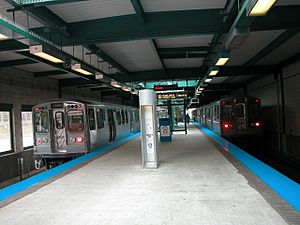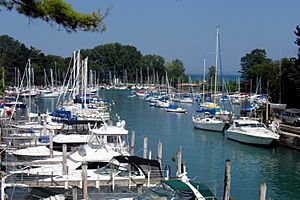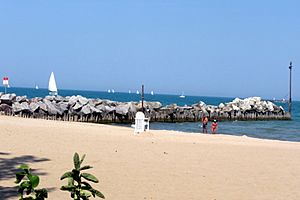Wilmette, Illinois facts for kids
Quick facts for kids
Wilmette, Illinois
|
||
|---|---|---|

Bahá'í House of Worship
|
||
|
||
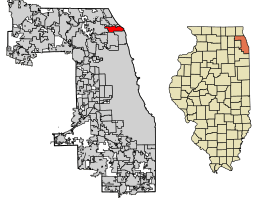
Location of Wilmette in Cook County, Illinois.
|
||
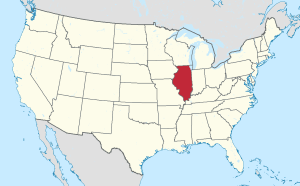
Location of Illinois in the United States
|
||
| Country | United States | |
| State | Illinois | |
| County | Cook | |
| Township | New Trier Township | |
| Founded | 1872 | |
| Area | ||
| • Total | 5.41 sq mi (14.01 km2) | |
| • Land | 5.40 sq mi (13.99 km2) | |
| • Water | 0.01 sq mi (0.02 km2) | |
| Elevation | 636 ft (194 m) | |
| Population
(2020)
|
||
| • Total | 28,170 | |
| • Density | 5,215.70/sq mi (2,013.63/km2) | |
| Standard of living (2015-19) | ||
| • Per capita income | $87,576 | |
| Time zone | UTC-6 (CST) | |
| • Summer (DST) | UTC-5 (CDT) | |
| ZIP Code(s) |
60091
|
|
| Area code(s) | 847 and 224 | |
| FIPS code | 17-82075 | |
| Wikimedia Commons | Wilmette, Illinois | |
Wilmette is a village in New Trier Township, Cook County, Illinois, United States. Bordering Lake Michigan, it is located 14 miles (23 km) north of Chicago's downtown district (4 mi or 6 km from Chicago's northern border) and had a population at the 2010 census of 27,087. In 2020, Wilmette was ranked by Niche.com as the best place to raise a family in Cook County based on a variety of factors including public schools grade, percentage of residents with a bachelors degree or higher, crime & safety grade, family amenities, walkability grade, percentage of households with children, and access to parks and other recreational activities. Wilmette is also home to Central Elementary School and Romona Elementary School, both recent recipients of the National Blue Ribbon award bestowed by the U.S. Department of Education.
Contents
Geography
Wilmette is located on the western shore of Lake Michigan and is a near northern suburb of Chicago, immediately North of Evanston at 42°4′38″N 87°43′25″W / 42.07722°N 87.72361°W (42.077178, -87.723736). The North Shore Channel drainage canal empties into Lake Michigan at Wilmette Harbor.
According to the 2010 census, Wilmette has a total area of 5.409 square miles (14.01 km2), of which 5.4 square miles (13.99 km2) (or 99.83%) is land and 0.009 square miles (0.02 km2) (or 0.17%) is water.
Wilmette has a well-developed urban forest and since 1983 has enjoyed "Tree City" status. As of 2006, village parkways hosted more than 18,600 trees comprising 150 species and sub-species.
Demographics
| Historical population | |||
|---|---|---|---|
| Census | Pop. | %± | |
| 1880 | 419 | — | |
| 1890 | 1,458 | 248.0% | |
| 1900 | 2,300 | 57.8% | |
| 1910 | 4,943 | 114.9% | |
| 1920 | 7,814 | 58.1% | |
| 1930 | 15,233 | 94.9% | |
| 1940 | 17,226 | 13.1% | |
| 1950 | 18,162 | 5.4% | |
| 1960 | 28,268 | 55.6% | |
| 1970 | 32,134 | 13.7% | |
| 1980 | 28,229 | −12.2% | |
| 1990 | 26,530 | −6.0% | |
| 2000 | 27,651 | 4.2% | |
| 2010 | 27,087 | −2.0% | |
| 2020 | 28,170 | 4.0% | |
| Decennial US Census | |||
As of the census of 2010, there were 27,087 people, 9,742 households, and 7,533 families residing in the village. The population density was 5,016.1 people per square mile (1,934.8/km2). There were 10,290 housing units at an average density of 1,905.6 per square mile (735.0/km2). The racial makeup of the village was 85.5% White, 0.8% African American, 0.1% Native American, 10.8% Asian, 0.03% Pacific Islander, 0.8% some other race, and 2.1% from two or more races. Hispanic or Latino of any race were 3.3% of the population.
There were 9,742 households, out of which 40.4% had children under the age of 18 living with them, 68.3% were headed by married couples living together, 7.1% had a female householder with no husband present, and 22.7% were non-families. 20.8% of all households were made up of individual occupants, and 12.2% were someone living alone who was 65 years of age or older. The average household size was 2.77 and the average family size was 3.23.
In the village, the population was spread out, with 29.4% under the age of 18, 4.7% from 18 to 24, 16.4% from 25 to 44, 32.9% from 45 to 64, and 16.8% who were 65 years of age or older. The median age was 44.8 years. For every 100 females, there were 92.3 males. For every 100 females age 18 and over, there were 87.7 males.
For the period 2009–11, the estimated median annual income for a household in the village was $117,526, and the median income for a family was $144,885. Male full-time workers had a median income of $107,768 versus $61,939 for females. The per capita income for the village was $64,759. About 1.8% of families and 2.3% of the population were below the poverty line, including 1.5% of those under age 18 and 1.3% of those age 65 or over.
The village ranks 47th on the list of highest-income places in the United States with a population of over 10,000.
History
Before European settlement, a Potawatomi village was located on "Indian Hill", currently the site of a golf course in nearby Winnetka. The village is named in honor of Antoine Ouilmette, a French-Canadian fur trader married to Archange, a Potawatomi. For his part in persuading local Native Americans to sign the second Treaty of Prairie du Chien in 1829, the U.S. government awarded Ouilmette 1,280 acres (5.2 km2) of land in present-day Wilmette and Evanston.
German Catholic farmers from the area of Trier began settling the area in the 1840s. They named their village, which was centered west of Ridge Road, Gross Point. In 1848, Ouilmette sold his land to farmers and developers.
The Chicago and Milwaukee Railroad tracks were built in 1854, facilitating the settlement of what would become the North Shore. In 1857, John G. Westerfield built pickle and vinegar factories in the area. Other early commercial development included a cooperage, a brick kiln, and an icehouse.
In 1869, the Chicago & Milwaukee constructed the first station in the area. Within a few years, the village of Wilmette was incorporated, on September 19, 1872; the village of Gross Point was incorporated on September 19, 1874. September 19 is celebrated locally as Charter Day.
Wilmette was nearly annexed by its neighbor to the south, Evanston, in 1894 and 1897. Proponents wanted to take advantage of Evanston's then superior fire, police, and water works. One annexation referendum lost by a vote of 168 to 165; three others also failed.
The Chicago, North Shore and Milwaukee (North Shore Line) arrived in 1899 and connected with a Milwaukee Road line into Chicago.
Gross Point's municipal revenues were dependent on the 15 taverns in town. With Prohibition, these revenues disappeared and the village went bankrupt. It was annexed in two parts by Wilmette in 1924 and 1926.
A naval gunboat, named the USS Wilmette, was commissioned in 1918. The vessel was originally the SS Eastland, a passenger ship which in July 1915 rolled over in the Chicago River, resulting in the deaths of 844 passengers and crew and marking the largest loss of life from a single shipwreck in Great Lakes history. The gunboat served as a training ship for naval reservists in the 9th, 10th, and 11th Naval Districts and later trainees from the Naval Station Great Lakes. The gunboat was decommissioned in 1940. During August 1943 the Wilmette was given the honor of transporting President Franklin D. Roosevelt, Admiral William D. Leahy, James F. Byrnes and Harry Hopkins on a 10-day cruise to McGregor and Whitefish Bay to plan strategies for World War II.
In 1942, Wilmette annexed No Man's Land, an unincorporated triangular shoreline area bordering Kenilworth, in the vicinity of the present day Plaza del Lago, that had been the subject of numerous municipal disputes and the site of a failed club hotel complex.
The oldest surviving Bahá'í House of Worship was constructed in Wilmette between 1920 and 1953. See "Attractions" below.
Wilmette was also the site of a significant fireworks explosion. According to the 'Wilmette Life, an explosion occurred on March 24, 1978, at 1221 Cleveland Avenue. The owner of the home, George Murray Yule, "had an illegal fireworks factory in the basement of his home." As the newspaper notes, the house was destroyed and "Yule died two weeks later of burns and injuries suffered." Homes in the immediate vicinity were damaged. The sound of the explosion could be heard several miles away.
In 2012 Random House published Kurt Andersen's third novel, True Believers. The novel's three main characters grew up in Wilmette during the 1960s. The book is a gold mine of mid–twentieth century Wilmette history, including a reference to a Woolworth's store once located in the Eden's Plaza shopping center—as well as a prominent Encyclopædia Britannica sign once displayed on Wilmette Avenue.
Attractions
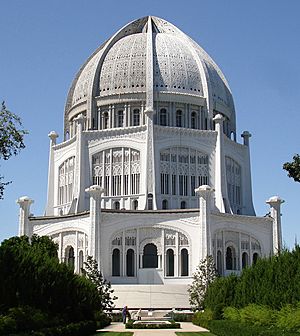
Wilmette is home to the Bahá'í House of Worship, the continental Bahá'í House of Worship for North America and presently the only one in the United States, as well as the administrative offices for the Bahá'í National Spiritual Assembly. In 2007 the house of worship was named as one of the "Seven Wonders of Illinois" by the Illinois Bureau of Tourism. It is open seven days a week to anyone who wishes to visit. There is no charge and no collection is taken.
Wilmette has a two-theater multiplex named the Wilmette Theater located on Central Avenue in one of its downtowns. The theater shows classic films, contemporary movies, as well as hosting live performances.
Wilmette has three shopping centers. One of them is Plaza del Lago, one of the nation's oldest shopping centers. It is located along Sheridan Road. The other two, Edens Plaza and West Lake Plaza, are on Lake Street east of the Edens Expressway.
Other attractions include Gillson Park with beach access, a marina, and an off-leash area for dogs; Langdon Beach; and Centennial Park, with a public swimming pool, tennis and ice-skating facilities. In 2013 the Wilmette Platform Tennis Club was developed, the new facility has 4 paddle tennis courts and a warming hut.
Gillson Park hosts a wide variety of activities that the whole family can enjoy. The beach has been a local attraction for decades. Swimming in the beach is only allowed in specific areas of the water. The park also provides its visitors with a part of the beach called the Dog Beach. The Dog Beach is located just south of the main public beach area. Here, visitors are allowed to bring their dogs for a fun day in the water. Depending on the weather conditions, the park's beaches may be temporarily closed in order to maintain the safety of the park's visitors.
Gillson Park also hosts a public theater, the Wallace Bowl, which is open during the summer season. This theater provides a variety of performances throughout the summer. The park also provides many opportunities for sports enthusiasts. Tennis courts are open from sunrise to after sunset, and there is space for people to play beach volleyball and soccer. Built-in grills for barbecuing are available throughout the park.
The Wilmette Golf Course, designed by Joe Roseman, is open to the public.
Architecture
In addition to the Bahá'í House of Worship, Wilmette is famous for several other examples of religious architecture.
The oldest existing church building in Wilmette is the First Congregational Church (1909) designed in the Tudor Revival style. Trinity United Methodist Church (1928) is a Neo-Gothic structure and was designed and constructed by Granger & Bollenbacher of Wisconsin Lannonstone. The church features stained glass windows by Willet Studios of Philadelphia, among the top American studios during the 1920s. The church was used as a filming location for Home Alone.
Both St. Joseph and St. Francis Xavier Church were designed by the firm of McCarthy, Smith and Eppig. St. Joseph's is Wilmette's oldest religious congregation, established in 1843. The present building (1939) is among the finest examples of Art Deco architecture on the North Shore. The interior is particularly well preserved and features Art Deco light fixtures and stained glass windows designed and fabricated by Giannini & Hilgart of Chicago. The altar floor and sanctuary wall contain Italian and French marble inlaid with Portuguese onyx. The Stations of the Cross are pastel-hued mosaics crafted in the Vatican Studio of Mosaics in Rome. The design and materials of the Y-shaped school designed by Herman J. Gaul of Chicago and constructed in 1934, and the adjacent rectory, harmonize with the church. St. Francis Xavier Church (1939) was designed in the Late Gothic Revival mode while McCarthy, Smith & Eppig were simultaneously working on St. Joseph's. The stained glass windows were made with English and German imported glass by the famed F. X. Zettler Studios of Munich and New York City. St Francis Xavier School (1924), just east of the church, is a unique modern blend of Gothic architecture by Chicago architect Barry Byrne.
Wilmette has two houses built by Frank Lloyd Wright: the Frank J. Baker House (and carriage house) and the Lewis Burleigh House (also known as the JJ O'Connor House).
Historic preservation
These places in Wilmette are on the National Register of Historic Places:
| Site | Address | Listed |
|---|---|---|
| Baha'i Temple | 100 Linden Ave. | 1978 |
| Bailey-Michelet House | 1028 Sheridan Rd. | 1982 |
| Frank J. Baker House | 507 Lake Ave. | 1974 |
| Alfred Bersbach House | 1120 Michigan Ave. | 2003 |
| Chicago and Northwestern Depot | 1135-1141 Wilmette Ave. | 1975 |
| Gross Point Village Hall | 609 Ridge Rd. | 1991 |
| Linden Purple Line Terminal | 349 Linden Ave. | 1984 |
| Oak Circle Historic District | 318-351 Oak Circle | 2001 |
| Ouilmette North Historic District | 46 blocks: Chesnut Ave, Sheridan Rd., Lake Ave. and 13th St. | 2005 |
Transportation
Wilmette is currently served by the Chicago Transit Authority's Purple Line, the Metra commuter trains operated by Union Pacific Railroad on the old Chicago & Northwestern Railway line, and by the Pace suburban bus system. The northernmost station of the Purple Line is located at Linden Avenue in Wilmette. Wilmette's commuter railroad station is at Green Bay Road between Central and Lake Avenues.
The North Shore Line served Wilmette from 1899 until 1955.
Sustainability
The village of Wilmette has a stated commitment to "promoting and creating a more sustainable environment through energy efficiency, improved stormwater management, water conservation, pollution reduction, and recycling." Wilmette and 11 other communities are competing in the ComEd Community Energy Challenge for a $100,000 prize for energy consumption reduction. The village has implemented some lighting and heating efficiency programs in some municipal buildings. Each year since 2010, the village partners with Go Green Wilmette to present Going Green Matters: Wilmette's Green Fair, a sustainable living and recycling event that attracts over 1,000 residents, exhibitors, vendors, and activists.
Sister cities
Wilmette's sister city in Australia is Mona Vale in Pittwater Council, New South Wales, and they participate in an annual student exchange program between their high schools. Mona Vale and Wilmette are connected spiritually as well: each is home to a continental Bahá'í House of Worship.
- Ebner, Michael. Creating Chicago's North Shore: A Suburban History. 1988.
- Holley, Horace. Wilmette Story. 1951.
 |
Northfield | Winnetka | Kenilworth |  |
| Glenview | Lake Michigan | |||
| Skokie | Evanston | Evanston |
Sports and recreation
The Wilmette Park District oversees over 300 acres of parks and open land including Gillson Park and Beaches; Keay Nature Center; the Community Playfield, Mallinckrodt Park and a portion of the Green Bay Bike Trail. Five facilities including the Lakeview Center; Centennial Recreation Complex; the Community Recreation Center; the Wilmette Golf Club and the Mallinckrodt Center house Park District programs and activities. Neighborhood parks can be found in 15 additional locations throughout the village. A wide range of recreation programming encompasses children and adults from four months old to seniors.
The Wilmette Park District's Community Recreation Center has a 10,000-sq ft gymnastics facility. In 2013 the Wilmette Platform Tennis Club was opened. The Wilmette Platform Tennis Club has four paddle tennis courts and a warming hut.
Beaches
Wilmette contains three public beaches, a large one at the 60 acre Gilson Park and two smaller ones at Langdon Park and the Elmwood Dunes Preserve. The beaches have been a local family attraction for decades. Swimming is allowed only in specific areas. The park also provides a dog beach which is located south of the main public beach area. Depending on weather conditions, the park's beaches may be temporarily closed in order to maintain the safety of the park's visitors. Gilson Park also hosts a public theater, the Wallace Bowl, which provides a variety of performances throughout the summer. Tennis courts are open from sunrise to after sunset, and there is space for people to play beach volleyball and soccer. Gillson Park also has a marina (Wilmette Harbor) and built-in grills for barbecuing located throughout the park.
Centennial Park
Wilmette's Centennial Park contains a public swimming pool, tennis and indoor ice-skating facilities. The park's ice-skating center (Centennial Ice Center) is a member of the United States Figure Skating Association and the Ice Skating Institute (ISI). The Ice Center is home to ISI class programs instructing over 3,000 skaters a year and ISI hockey classes instructing over 500 skaters a year. It is used by the Wilmette Hockey Association, Wilmette Tribe Hockey Club, New Trier High School Hockey Club, Loyola Academy Hockey Club, and Loyola University Hockey Club, the Wilmette Cougars Women's Hockey Club, Tom McDaniels Adult Hockey Hockey North America Adult Hockey, the Loyola Academy Thanksgiving High School Hockey Invitational Tournament, and a "Mid-Summer Classic" ISI Competition. The Wilmette Tennis Club features eight indoor tennis courts at Centennial Park.
Curling
The 1972 United States Men's Curling Championship was held in Wilmette. The event served as a qualifier to decide which team would represent United States the 1972 World Curling Championships.
The Wilmette Curling Club won the 1985 United States Men's Curling Championship. The club represented the United States at the 1985 men's World Curling Championships where they ultimately tied with Denmark to place 3rd overall.
Golf
The village is home to Wilmette Golf Course, designed by Joe Roseman, which is open to the public. The golf course is a facility of the Wilmette Park District. The village is also home to a private golf course at Westmoreland Country Club, established in 1911. The Canal Shores golf course straddles the border of Wilmette and Evanston.
Education
For grade school education, Wilmette is served by Wilmette Public Schools District 39 which includes elementary schools (grades K–4) Central, Harper, McKenzie, and Romona, Highcrest Middle School (grades 5 & 6), and Wilmette Junior High School (grades 7 & 8). Marie Murphy School, also located in Wilmette, is part of Avoca School District 37. It has the longest school day in the state of Illinois.
There are also several parochial elementary schools in the area, including St. Francis Xavier (K-8) and St. Joseph (Pre-K to K). Other private schools in Wilmette include the Ronald Knox Montessori School (Pre-K to K) and Baker Demonstration School (Pre-K to 8).
For public secondary or high school education, serving grades 9 to 12, Wilmette students attend New Trier High School. High school freshmen attend classes at the Northfield campus while other grades attend the Winnetka campus. Wilmette is also home to Catholic high schools Loyola Academy and Regina Dominican High School.
The Wilmette Public Library provides educational support to students at all grade levels, including those residing in neighboring Kenilworth.
In 2006, National Louis University closed its former main site, which had 6.5 acres (2.6 ha) of land, with about 66% in Wilmette and the remainder in Evanston.
Notable people
Images for kids
See also
 In Spanish: Wilmette para niños
In Spanish: Wilmette para niños




